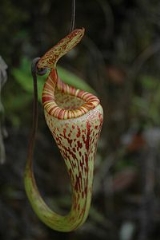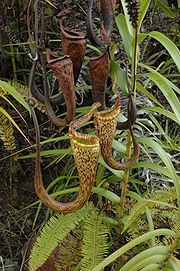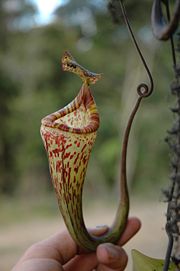
Nepenthes vogelii
Encyclopedia
Nepenthes vogelii is a tropical pitcher plant
endemic to Borneo
. It is thought to be most closely related to N. fusca
.
in Gunung Mulu National Park
by forest botanist J. A. R. Anderson. The material, labelled as N. fusca
, was deposited at the Sarawak Forestry Department herbarium
. In 1969, botanist Shigeo Kurata
examined this specimen and noted that it did not fall within the known variation exhibited by N. fusca.
Nepenthes vogelii was formally described
in 2002 by Andre Schuiteman and Eduard Ferdinand de Vogel. The description was published in the botanical journal Blumea
and is based on a single cultivated specimen, A.Vogel, A.Schuiteman & T.Roelfsema 981037 (SAR). This specimen was collected as a seedling in the Kelabit Highlands
of Sarawak
in 1997 and subsequently raised to maturity by Art Vogel, botanist and former conservatory manager of the Hortus Botanicus Leiden
. Nepenthes vogelii is named in his honour.
Some time prior to its description, N. vogelii entered cultivation through Ch'ien Lee
's Malesiana Tropicals plant nursery under the name "Nepenthes spec. 4".
Few specimens of this species are deposited in herbaria, likely due to its epiphytic
growth habit, which makes it hard to find without the aid of binoculars
.
Upper pitchers are generally infundibular, although their shape may vary from narrowly funnel-shaped to distinctly bulbous in the upper portion. This bulbous portion corresponds to the upper waxy zone of the inner surface.

than previously thought. Initially believed to be endemic to northern Sarawak
, it is now known from southern Sabah
and West Kalimantan
. The species has an altitudinal distribution of 1000 to 1500 m above sea level.
Nepenthes vogelii typically occurs as an epiphyte
in submontane or tall lower montane forest. The type specimen was found growing terrestrially among moss
in wet kerangas forest
. The plant was sympatric with N. stenophylla
and N. veitchii
. Despite this, no natural hybrids involving N. vogelii have been recorded.
On Mount Mulu
, N. vogelii occurs in a narrow altitudinal band (1200 to 1500 m) where its distribution does not overlap with those of the likewise epiphytic N. fusca
and N. hurrelliana
, which grow below 1200 m and above 1500 m, respectively.
 Nepenthes vogelii is thought to be most closely related to N. fusca
Nepenthes vogelii is thought to be most closely related to N. fusca
. It differs from that species in having much smaller pitchers and lacking appendages on the underside of the lid. In addition, the lid of N. vogelii is broadly triangular as opposed to the narrowly triangular lid of N. fusca. The colour of the pitchers—light cream with dark speckles—is also distinctive. These features also distinguish it from N. burbidgeae
and N. stenophylla
.
Nepenthes vogelii shows close affinities to N. platychila
. However, unlike the lower pitchers of N. vogelii, those of N. platychila bear wings and have a relatively wide peristome.
Pitcher plant
Pitcher plants are carnivorous plants whose prey-trapping mechanism features a deep cavity filled with liquid known as a pitfall trap. It has been widely assumed that the various sorts of pitfall trap evolved from rolled leaves, with selection pressure favouring more deeply cupped leaves over...
endemic to Borneo
Borneo
Borneo is the third largest island in the world and is located north of Java Island, Indonesia, at the geographic centre of Maritime Southeast Asia....
. It is thought to be most closely related to N. fusca
Nepenthes fusca
Nepenthes fusca , or the Dusky Pitcher-Plant, is a tropical pitcher plant endemic to Borneo. It is found throughout a wide altitudinal range and is almost always epiphytic in nature, primarily growing in mossy forest....
.
Botanical history
The first known collection of N. vogelii was made in 1961 on Mount ApiMount Api
Mount Api is a limestone mountain located in Gunung Mulu National Park in Sarawak, Malaysia. Neighbouring Mount Benarat and Mount Buda are part of the same formation...
in Gunung Mulu National Park
Gunung Mulu National Park
Gunung Mulu National Park near Miri, Sarawak, Malaysian Borneo, is a UNESCO World Heritage Site that encompasses incredible caves and karst formations in a mountainous equatorial rainforest setting...
by forest botanist J. A. R. Anderson. The material, labelled as N. fusca
Nepenthes fusca
Nepenthes fusca , or the Dusky Pitcher-Plant, is a tropical pitcher plant endemic to Borneo. It is found throughout a wide altitudinal range and is almost always epiphytic in nature, primarily growing in mossy forest....
, was deposited at the Sarawak Forestry Department herbarium
Herbarium
In botany, a herbarium – sometimes known by the Anglicized term herbar – is a collection of preserved plant specimens. These specimens may be whole plants or plant parts: these will usually be in a dried form, mounted on a sheet, but depending upon the material may also be kept in...
. In 1969, botanist Shigeo Kurata
Shigeo Kurata
is a Japanese botanist and Nepenthes taxonomist whose work in the 1960s and 1970s contributed much to the current popularity of these plants. Of particular note is his 1976 guide, Nepenthes of Mount Kinabalu....
examined this specimen and noted that it did not fall within the known variation exhibited by N. fusca.
Nepenthes vogelii was formally described
Species description
A species description or type description is a formal description of a newly discovered species, usually in the form of a scientific paper. Its purpose is to give a clear description of a new species of organism and explain how it differs from species which have been described previously, or are...
in 2002 by Andre Schuiteman and Eduard Ferdinand de Vogel. The description was published in the botanical journal Blumea
Blumea (journal)
Blumea - Journal of Plant Taxonomy and Plant Geography is a peer-reviewed journal of botany published by the National Herbarium of the Netherlands.Except for a short period during World War II, Blumea has been published continuously since 1934...
and is based on a single cultivated specimen, A.Vogel, A.Schuiteman & T.Roelfsema 981037 (SAR). This specimen was collected as a seedling in the Kelabit Highlands
Kelabit Highlands
The Kelabit Highlands are a mountain range located in the northernmost part of Sarawak, on the island of Borneo. The highest mountains in this range are Mount Murud at 2,423 m , Bukit Batu Buli at 2,082 m , and Bukit Batu Lawi at 2,046 m .In the Kelabit Highlands, there are 14...
of Sarawak
Sarawak
Sarawak is one of two Malaysian states on the island of Borneo. Known as Bumi Kenyalang , Sarawak is situated on the north-west of the island. It is the largest state in Malaysia followed by Sabah, the second largest state located to the North- East.The administrative capital is Kuching, which...
in 1997 and subsequently raised to maturity by Art Vogel, botanist and former conservatory manager of the Hortus Botanicus Leiden
Hortus Botanicus Leiden
The Hortus botanicus of Leiden is the oldest botanical garden of the Netherlands, and one of the oldest in the world. It is located in the southwestern part of the historical centre of the city, between the Academy building and the Leiden Observatory....
. Nepenthes vogelii is named in his honour.
Some time prior to its description, N. vogelii entered cultivation through Ch'ien Lee
Ch'ien Lee
Ch'ien C. Lee is a photographer and botanist specialising in the carnivorous plant genus Nepenthes. Lee has described several new Nepenthes species, including N. chaniana, N. gantungensis, N. glandulifera, N. jamban, N. lingulata, N. palawanensis, N. pitopangii,...
's Malesiana Tropicals plant nursery under the name "Nepenthes spec. 4".
Few specimens of this species are deposited in herbaria, likely due to its epiphytic
Epiphyte
An epiphyte is a plant that grows upon another plant non-parasitically or sometimes upon some other object , derives its moisture and nutrients from the air and rain and sometimes from debris accumulating around it, and is found in the temperate zone and in the...
growth habit, which makes it hard to find without the aid of binoculars
Binoculars
Binoculars, field glasses or binocular telescopes are a pair of identical or mirror-symmetrical telescopes mounted side-by-side and aligned to point accurately in the same direction, allowing the viewer to use both eyes when viewing distant objects...
.
Description
Rosette and lower pitchers are cylindrical throughout and have a small horizontal mouth. Unusually, they lack ventral wings. The lid is broadly triangular and lacks appendages. Pitchers are yellowish with dark speckles and a striped peristome.Upper pitchers are generally infundibular, although their shape may vary from narrowly funnel-shaped to distinctly bulbous in the upper portion. This bulbous portion corresponds to the upper waxy zone of the inner surface.

Ecology
Despite only being recorded from several scattered localities, N. vogelii appears to be more widespread in BorneoBorneo
Borneo is the third largest island in the world and is located north of Java Island, Indonesia, at the geographic centre of Maritime Southeast Asia....
than previously thought. Initially believed to be endemic to northern Sarawak
Sarawak
Sarawak is one of two Malaysian states on the island of Borneo. Known as Bumi Kenyalang , Sarawak is situated on the north-west of the island. It is the largest state in Malaysia followed by Sabah, the second largest state located to the North- East.The administrative capital is Kuching, which...
, it is now known from southern Sabah
Sabah
Sabah is one of 13 member states of Malaysia. It is located on the northern portion of the island of Borneo. It is the second largest state in the country after Sarawak, which it borders on its southwest. It also shares a border with the province of East Kalimantan of Indonesia in the south...
and West Kalimantan
West Kalimantan
West Kalimantan is a province of Indonesia. It is one of four Indonesian provinces in Kalimantan, the Indonesian part of the island of Borneo. Its capital city Pontianak is located right on the Equator....
. The species has an altitudinal distribution of 1000 to 1500 m above sea level.
Nepenthes vogelii typically occurs as an epiphyte
Epiphyte
An epiphyte is a plant that grows upon another plant non-parasitically or sometimes upon some other object , derives its moisture and nutrients from the air and rain and sometimes from debris accumulating around it, and is found in the temperate zone and in the...
in submontane or tall lower montane forest. The type specimen was found growing terrestrially among moss
Moss
Mosses are small, soft plants that are typically 1–10 cm tall, though some species are much larger. They commonly grow close together in clumps or mats in damp or shady locations. They do not have flowers or seeds, and their simple leaves cover the thin wiry stems...
in wet kerangas forest
Kerangas forest
Sundaland heath forest, also known as Kerangas forest, is a type of tropical moist forest found on the island of Borneo, which is divided between Brunei, Indonesia, and Malaysia, as well as on the Indonesian islands of Belitung and Bangka, which lie to the west of Borneo.-Setting:The word Kerangas,...
. The plant was sympatric with N. stenophylla
Nepenthes stenophylla
Nepenthes stenophylla , or the Narrow-Leaved Pitcher-Plant, is a tropical pitcher plant endemic to Borneo. The species produces attractive funnel-shaped pitchers up to 25 cm high...
and N. veitchii
Nepenthes veitchii
Nepenthes veitchii |James Veitch]], nurseryman of the Veitch Nurseries), or Veitch's Pitcher-Plant, is a Nepenthes species from the island of Borneo. The plant is widespread in north-western Borneo and can also be found in parts of Kalimantan. N...
. Despite this, no natural hybrids involving N. vogelii have been recorded.
On Mount Mulu
Mount Mulu
Mount Mulu is a sandstone and shale mountain. At 2376 m, it is the second highest mountain in the state of Sarawak, after Mount Murud. It is located within the boundaries of Gunung Mulu National Park, which is named after it....
, N. vogelii occurs in a narrow altitudinal band (1200 to 1500 m) where its distribution does not overlap with those of the likewise epiphytic N. fusca
Nepenthes fusca
Nepenthes fusca , or the Dusky Pitcher-Plant, is a tropical pitcher plant endemic to Borneo. It is found throughout a wide altitudinal range and is almost always epiphytic in nature, primarily growing in mossy forest....
and N. hurrelliana
Nepenthes hurrelliana
Nepenthes hurrelliana is a tropical pitcher plant endemic to Borneo, where it has been recorded from northern Sarawak, southwestern Sabah, and Brunei. It is of putative hybrid origin; its two original parent species are thought to be N. fusca and N. veitchii...
, which grow below 1200 m and above 1500 m, respectively.
Related species

Nepenthes fusca
Nepenthes fusca , or the Dusky Pitcher-Plant, is a tropical pitcher plant endemic to Borneo. It is found throughout a wide altitudinal range and is almost always epiphytic in nature, primarily growing in mossy forest....
. It differs from that species in having much smaller pitchers and lacking appendages on the underside of the lid. In addition, the lid of N. vogelii is broadly triangular as opposed to the narrowly triangular lid of N. fusca. The colour of the pitchers—light cream with dark speckles—is also distinctive. These features also distinguish it from N. burbidgeae
Nepenthes burbidgeae
Nepenthes burbidgeae , also known as the painted pitcher plant or Burbidge's Pitcher-Plant, is a tropical pitcher plant with a patchy distribution around Mount Kinabalu and neighbouring Mount Tambuyukon in Sabah, Borneo.-Botanical history:...
and N. stenophylla
Nepenthes stenophylla
Nepenthes stenophylla , or the Narrow-Leaved Pitcher-Plant, is a tropical pitcher plant endemic to Borneo. The species produces attractive funnel-shaped pitchers up to 25 cm high...
.
Nepenthes vogelii shows close affinities to N. platychila
Nepenthes platychila
Nepenthes platychila is a species of pitcher plant endemic to the Hose Mountains of central Sarawak. It is notable for its smooth peristome and funnel-shaped upper pitchers....
. However, unlike the lower pitchers of N. vogelii, those of N. platychila bear wings and have a relatively wide peristome.

